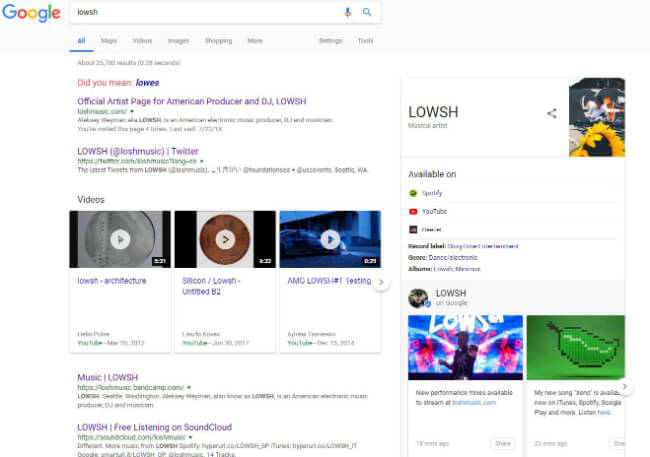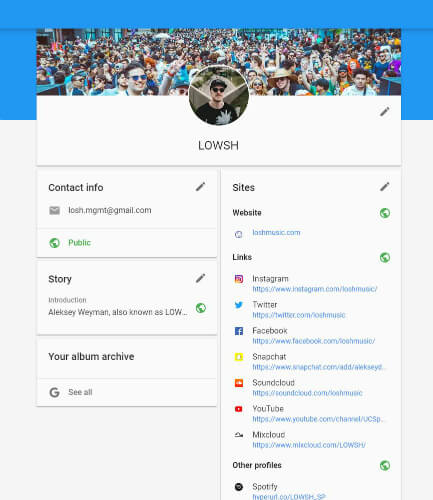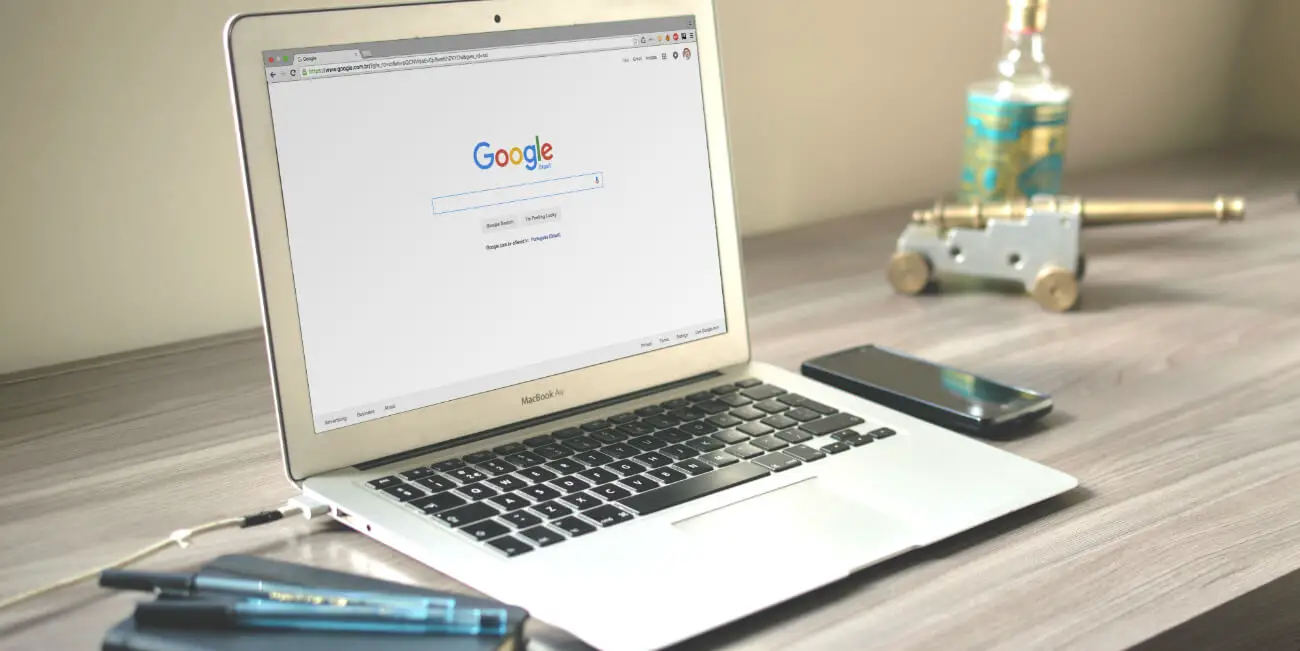
How To Create A Google Knowledge Panel
Have you ever conducted a Google search for a music artist or business/brand and found a visual panel on the right side of the search results page that offers various links about the brand, their biography, images and more?
That’s called a Google Knowledge Panel and it's an absolute necessity if you represent a professional brand or company entity online. In my case, I created my own Google Knowledge Panel for my music brand- LOWSH and it only took a few steps. See the screenshot below!

In this article, I will share a few key parts the Google Knowledge Panel creation and verification process, as well as address some frequent questions I've received in the past! Here's what we'll be covering:
- How to feed your brands content to Googles knowledge graph
- Tips for how your Google brand account needs to look BEFORE seeking verification
- What to expect when you go for Google verification
- Reasons why your knowledge panel may not be appearing right away
- Frequently asked questions about creating Google Knowledge Panels
Google Knowledge Panels not only provide a professional looking "business card” for your brand, they also help to improve SEO (Search Engine Optimization), since Google collects information from various online sources and adds it to their Knowledge Graph about your brand. There are other benefits to having a Google Knowledge Panel, such as increased organic discovery on Google and brand reputation, to name a few. Think of a knowledge panel as a Wikipedia page for your brand, but it appears on Google search result pages! For me personally, having a Google Knowledge Panel has been a huge with increasing organic leads, as well as offering more professional representation of my brand. So how exactly did I get a Google knowledge panel, and is it possible for you to create one too?
1. Create a Google Brand Account.
The first step to getting a Google knowledge panel is to have a Google brand account specifically for your brand. A brand account is different than a standard account, in that a brand account can be linked (administrated/managed) by multiple users (user accounts). This is often done to share administrative rights between multiple individuals. Here is a link to where you can view brand accounts under your currently signed-in Google account. If you’ve never set up a brand account, here are the steps for how you can do so.
Note that as of April 2019, Google+ accounts are being deprecated. Google Brand accounts will remain however, and can also be tied to YouTube channels. In my case, I have a personal Google account that manages my brand account- this helps with easier sign-in processes. Once you have your brand account set up, you might even consider setting up a referral funnel to increase leads (it has worked for me).
2. Update Your Google Brand Account With Detailed Information.
Once you have a Google brand account, you need to update it with as MUCH relevant information as possible. This includes all social profiles, website URLs, biographies, and more. When submitting an application for a verified Google Knowledge Panel, Google looks at the quantity, quality, and legitimacy of the information provided on your Google Brand account. This is (partially) the information that eventually gets added to Google's knowledge graph. In my case, I fed Google with information regarding my music brands previous shows, musical releases on streaming platforms, online photographs/video content, and more. The goal is to prove to Google that you are who you claim to be.
At this point, Google will be looking to confirm key indicators about your brand; such as:
- Do you have a valid website?
- Does your business have social media accounts? Are they listed?
- If you're a musician/band, do you have links to your music on Spotify, iTunes, YouTube, etc?
- Does your brand name appear in notable press releases or articles?
This process of adding links helps Google distinguish brands who are legit from those that aren’t. Those that are legitimate and have some level of professionalism, are ready to have their own Google Knowledge Panel. Be sure that all information in your brand account is set to public, so Google can publicly access it. Take a look at the information I’ve provided on my own knowledge panel for LOWSH as an example:

3. Optimize Your Google SEO
When you perform a Google search for your brand name, you should already be appearing in the top three or four results in search engines. This is actually fairly easy to achieve if your brand has social media profiles on Facebook, Instagram, Twitter, YouTube and (if you’re making music), Soundcloud. Although identifying the exact ranking of your webpages and profiles in Google search results is near impossible, there are ways to evaluate your general ranking on SERPs. That's a whole different topic in itself, but if there's one thing to remember here- it's that search queries for topics relevant to your brand, should get people to your websites.
Another important item to remember is that the information on each of your social media/online platforms needs to be closely identical to each other. This helps Google connect the dots that all of your accounts are related to the same entity- your brand! If you have a website, you should make sure your structured data is aligned with content on your social media, blogs, etc. One great way to maintain consistency across various platforms is to use a consistent biography. Here’s the one I use for my brand LOWSH:
Aleksey Weyman, also known as LOWSG (@lowshmusic), is an American electronic music producer, DJ and musician.
Short yet descriptive, it describes my music brand perfectly and when consistent across all platforms, helps Google connect the dots about who I am.
Note: If you're trying to get your music brand more exposure, then I highly suggest adding your music to Google Play, since it’s part of the Google family and will increase your chances of getting an official Google Knowledge Panel. Here's an article about how to get your music on streaming platforms (including Google Play) if you are in this space and curious about how it works.
4. Submit your Website to Google Search Console
Google now needs to connect the dots between your brand account and your brands' websites, to confirm that you are who you say you are. If you don't yet have a website yet, here's a guide for how I built my simple, static wesite on AWS (Amazon Web Services) S3. It does require some technical ability but there are alternative web builders out there, just not as cheap as how I did it lol.
In this final step, you'll need to let Google know that your website is managed by the account that is trying to create a panel. Here is a link to where you can submit your website to Google Search Console (select "add property"). Only do this after making sure that everything on your Google brand account is clean, consistent and updated. After submitting your site to the link above, Google should now have enough content to understand your brand and begin formulating your Google Knowledge Panel. While this process is not immediately guaranteed, you should begin to see a small panel populating in search results after a few days time. If you don't see anything after a week, consider adding more content to your Google brand account. Frequent updates and double checking the relevancy of your links/content/etc is the best way to feed Google the latest info about your brand, which will help them update your knowledge panel more effectively.
In my experience, it took about a week to begin seeing knowledge panel content for my music brand LOWSH. I have to first search for "LOWSH music", since my brand was in the music space and this query allowed Google to more accurately provide search results for my brand. Thankfully because "LOWSH" is uncommon enough of a name, I was able to quickly discard the need to include "music" in the search. After about two weeks, my panel fully appeared and I was able to proceed to the next step- claiming it!
5. Get Verified on Google
Once you start seeing you Google knowledge panel content in search results, you’ll see the below option (screenshot). This option is indicating that there is a panel but nobody technically "owns" it yet. This is because although Google is generating the content from your links and brand account online, they have not yet verified that you are the person who will be overseeing or "managing" this panel. Note that you have to be signed in to you Google account that manages the brand (the one that created the Google brand account) in order to proceed with claiming ownership of your panel. Verifying your brand on Google is how you get a branded knowledge panel, which gives you even more flexibility with adjusting what is displayed.

When you click the image above, you'll be directed to the Google brand verification form. You’re almost there! This form will request verification screenshots of your brand accounts (make sure to show edit privileges in the screenshots) as well as a personal photo with your ID card, and phone number. All this information is required by Google to prove that you are the official owner of your business/brand that you're requesting access to.
The important thing to remember about this form, is that you need to provide as much detailed information as possible, do NOT complete this form half-heartedly. If you don’t have the proper amount of credentials, go back and get those set up. After you submit the application, Google will usually send you an email within several days on the status of your application. Sometimes, they may request more information to verify your ownership. In my case, I spent some time carefully filling out the form so as to not risk any pushback from Google. Note that verification on Google is similar to Google My Business, where businesses will get local panels that appear in the search results page. These panel types however rare more specific to businesses who have physical locations, whereas a Google Knowledge Panel is moreso for notable entities / brands.
People also ask..
There are a lot of nuances that go into creating / getting a Google Knowledge Panel, and so I will answer some of the most common questions I've received from readers in the past. If you have more questions, please reach out to me directly and I will be happy to assist.
Can anyone have a Google Knowledge Panel?
Google Knowledge Panels are designed for any business brand or notable entity that has significant presence online and some level of notoriety. For my music brand, I perform a lot of shows and have music on all of the major streaming platforms with hundreds of thousands of streams. As well as YouTube videos, interviews with notable blogs, and more. The process of creating / getting a knowledge panel is certainly available for everyone but those that have proven digital presence are the most likely to get one from Google.
How do I Create a Google Knowledge Base?
A knowledge base is a collection of resources that help validate your brand and educate readers, which Google then groups together to create a knowledge cloud or graph. More information about how this graph works can be found on Googles support website. In my experience, the best way to feed Google this grouped information is to keep all of your online account bios the same (same verbiage, copy, etc) as this makes it extremely easy for Google to establish the connection. If your biographies are all varied and inconsistent, Google will have a hard time grouping them together in their knowledge graph.
How does Google decide who gets a knowledge panel?
Google performs a variety of automated checks when establishing the basis of a Google knowledge panel. The knowledge graph is a primarily automated system, utilizing machine learning and data analysis to perform the connections between your accounts. However, the verification process is a lot more hands on, which is why it's important to make sure that all of your content is up to date and you complete the verification form completely (including phone number, picture of ID, etc). Failure to provide the necessary information can lead to a very quick rejection of verification, which may stunt your knowledge panels presence indefinitely.
What happens when you claim a knowledge panel on Google?
When you finally claim your knowledge panel, you will have exclusive access to push suggested updates to your panel. This can be very effective when dealing with timely updates that coincide with major business changes, product launches, etc. By being able to expedite the updates to your panel, you can effectively tell Google what you want them to display. It's important to note that the content still has to pertain to your brand, as Google can at anytime choose to change it back to the original content that was displayed. In my case, I use the updates feature when I am doing a branding design shift, or have a new profile image that I want to appear on Google instead of my current one.
Conclusion
Voila! After Google accepts your application, your brand will be fully verified and look professional as heck. You'll be able to upload a featured image (like a profile pic), customize live links on the fly, and more! If you found this guide helpful, check out some of our other helpful guides on the Millennial Moderator home page and sign up for our newsletter to get the latest Mods before anyone else, sent directly to your email!
Please also consider sharing this Mod using the social media icons below. Any questions or comments? Let me know on Twitter!

